10 Persuasive Writing Techniques to 10X Your Marketing Copy


Persuasion is a powerful word for anyone in the marketing space.
The ultimate goal of your marketing, after all, is to persuade people to buy from you.
But how do you persuade people when everyone seems to sell them something? What tools do you have at your disposal to make your writing more persuasive?
Today, I want to answer all these questions for you by first showing you the persuasion strategy a Nobel-winning laureate developed that will transform the way you write your copy.
Then, I want to share my favorite ten persuasive techniques that will 10x your copy fast.
Let’s get started.
Persuasive writing is a method that leverages human biases to make a message more attractive in the eye of the recipient.
If I asked you whether you are a rational or an irrational person, what would you say? Most likely, you’d pick the former.
Sure, you can get emotional every so often, but most likely, you are in charge of your emotions, thoughts, and actions.
Other people are dumb and irrational, but you’re not. You’re different.
In reality, all humans fall for the same irrational behaviors and thinking patterns. We consistently make cognitive mistakes that go against our self-interest, despite our deepest efforts not to make them.
Consider smoking: every smoker knows he should stop doing it, but they can’t stop. Most smokers want to quit, but their addictions are simply too strong. It’s not that they can’t stop; it’s that they won’t.
We can say the same of highly indebted people; these are people who have maxed out their cards, yet they keep buying shit they don’t need.
Before the 1970s, economists used to think people were rational. Every decision people took was in favor of maximizing their utility—whether that was comfort, health, money, or anything else. Leave people be people, and they’ll do fine. If only it were so easy.
From the 70s onwards, some fringe economists started to question the normative view of human behavior in favor of a more descriptive one; a theory that could explain, for example, why people who win three bets in a row at the casino think they have a higher likelihood of keeping their winning streak, despite having no probabilistic (i.e., rational) reason to believe so. “They’re idiots,” you’d say, but it’s more than that. It’s that they’re humans; they can be irrational when given a chance.
According to a pair of Israeli psychologists, Daniel Kahneman, the 2002 Nobel Memorial Prize in Economic Sciences, and his partner Amos Tversky, humans don’t choose between two or more options based on the outcomes, but on the probability of their wins and loses.

I won’t dwell on the details of their “prospect theory,” as explained in their seminal paper of the same name, but on another part of their extensive theoretical bibliography, one that focuses on the way humans think.
According to Kahneman, who wrote the best-selling book Thinking, Fast and Slow based on his extensive research with Tversky, humans think through a pair systems:
In Kahneman’s words:
System 1 operates automatically and quickly, with little or no effort and no sense of voluntary control.
System 2 allocates attention to the effortful mental activities that demand it, including complex computations. The operations of System 2 are often associated with the subjective experience of agency, choice, and concentration.
While both systems work in tandem, more often than not, system 1 takes over the system 2, without us realizing it, making us do things we often can’t explain.
When we think of ourselves, we identify with System 2, the conscious, reasoning self that has beliefs, makes choices, and decides what to think about and what to do. Although System 2 believes itself to be where the action is, the automatic System 1 is the hero of the book.
I describe System 1 as effortlessly originating impressions and feelings that are the main sources of the explicit beliefs and deliberate choices of System 2. The automatic operations of System 1 generate surprisingly complex patterns of ideas, but only the slower System 2 can construct thoughts in an orderly series of steps.
The main takeaway from Kahneman’s theory is that as a marketer, your goal is to work with your prospect’s system 1. This system is what influences the rationale of your prospects, whether they’re aware of it or not.
If you ever made a purchase where everything “felt” right—a situation in which you didn’t need to be sold anything, you just wanted to buy that product—then your system 1 was influencing your system 2, thus overriding any second thought you may have had against that purchase.
System 1 continuously generates suggestions for System 2: impressions, intuitions, intentions, and feelings. If endorsed by System 2, impressions and intuitions turn into beliefs, and impulses turn into voluntary actions.
When all goes smoothly, which is most of the time, System 2 adopts the suggestions of System 1 with little or no modification. You generally believe your impressions and act on your desires, and that is fine—usually.
What I’m covering is just a tiny piece of Kahneman and Tversky’s theories; there’s a whole lot more to write about how both systems work and how biases influence people’s thinking.
For now, I want you to remember this:
The entire list of persuasive techniques featured in this article focus on leveraging your prospect’s system 1. If you use these persuasive techniques in your writing or advertising, you’ll be persuasive.
Let’s now take a quick look at a simple persuasion strategy you can use and adapt within your marketing campaigns.
To use the persuasion strategies laid below, you want to have a strategy that helps you tie all of them together in a logical fashion.
To this extent, I’ll use Roger Dooley’s Persuasion Slide, which he structured in the following way:
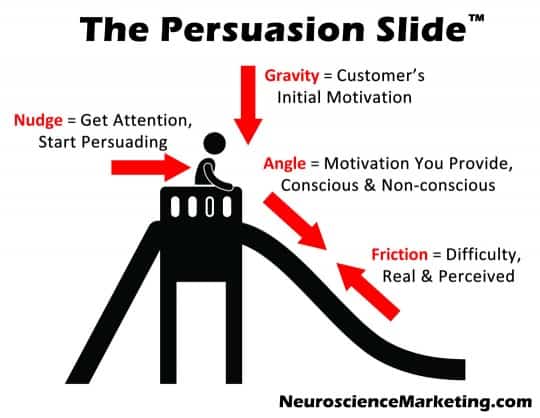
Here’s how this slide works:
The ten persuasion writing techniques you’ll see below will touch in any of the four elements of the persuasion slide. Whenever you pick one of the techniques, you’ll be affecting of these four elements.
Whatever technique you pick, make sure to remember the ultimate goal: having your visitor continue down the slide. And yes, the following list of persuasive writing techniques will work with your prospect’s system 1. I didn’t forget about that.
Without further ado, let’s dive deep into the ten techniques that will show you how to write persuasively.
Humans love stories. They are ingrained in our blood.
Back in the hunter-gatherer times, we used to transmit information through stories, whether they were legends, myths, or rumors; thus, we became wired to them.
Stories helped increase cooperation within tribes, as recently shown by researchers of the University College London, which in turn helped the dissemination of information, as new tools and technologies developed. This also allowed us to become much more technologically advanced and better organized than any other species.
Besides the anthropological explanation, there’s even a physiological reason why we love stories, one that makes us crave for them.
Whenever we hear a story, we secrete a hormone called oxytocin, which is synthesized in the hypothalamus and helps humans bond with each other. As Paul J. Zak, Ph.D., the man who first found the way this little peptide works, explains:
I now consider oxytocin the neurologic substrate for the Golden Rule: If you treat me well, in most cases my brain will synthesize oxytocin and this will motivate me to treat you well in return.
When your brain secretes oxytocin, you can feel empathy, kindness, and carry a cooperative attitude towards others. If you want to persuade people, you must engrain them into your messaging. Instead of telling your audience the benefits of your offer, you tell a story that shows those benefits. Stories are the packaging on which you transmit your ideas.
A similar analogy is the one used by Jonah Berger, a professor at the Wharton School of the University of Pennsylvania and author of Contagious: Why Things Catch On, which compares stories to a Trojan Horse:
[…] just like the epic tale of the Trojan Horse, stories are vessels that carry things such as morals and lessons. Information travels under the guise of what seems like idle chatter. So we need to build our own Trojan horses, embedding our products and ideas in stories that people want to tell. […] We need to make our message so integral to the narrative that people can’t tell the story without it.
In the simplest terms, a story has three parts:
There are many storytelling (or narrative) theories, many of which are incredibly complex. All of them have in common the same 3-part pattern, regardless of the way they structure them.

Your stories don’t need to be lengthy or complicated. You can use any of these three elements in a sentence, paragraph, or entire article.
Let’s take the following example:
I used to be a marketer, but it never felt quite right, so I decided to become a writer, and after a lot of practice, I started getting paid for my writing.
The underscored words are the introduction, the italics are the climax, and the bolded ones are the conclusion. Is this a good story? Nope. Is it one? Indeed it is.
If you haven’t noticed, that story is a synthesized version of my article on becoming a freelance writer. I could have easily explained that in a paragraph as well, but whatever the length, the story stays the same:
Let’s take a look at how you can start embedding stories (your Trojan horses) into your company.

How many times have you heard something like this?
“It’s an exclusive event for special guests; you can’t come.”
“It’s a special product that only a few selected clients can purchase.”
“It’s a unique product; only 50 of these have been manufactured.”
Exclusivity plays a key role in the way we perceive people, objects, or ideas. It makes them special, different, or, let’s face it, better.
When something it’s exclusive, it has a higher perceived value, its status is higher, and it’s better than the rest.
What makes something exclusive? Scarcity.
When something is scarce, people want it more. It’s the “2+2” of marketing; anyone knows that. Any economics 101 class will show you that the higher the demand of any given product and the lower its offer (i.e., the scarcer a given object is), the higher the price (or value).
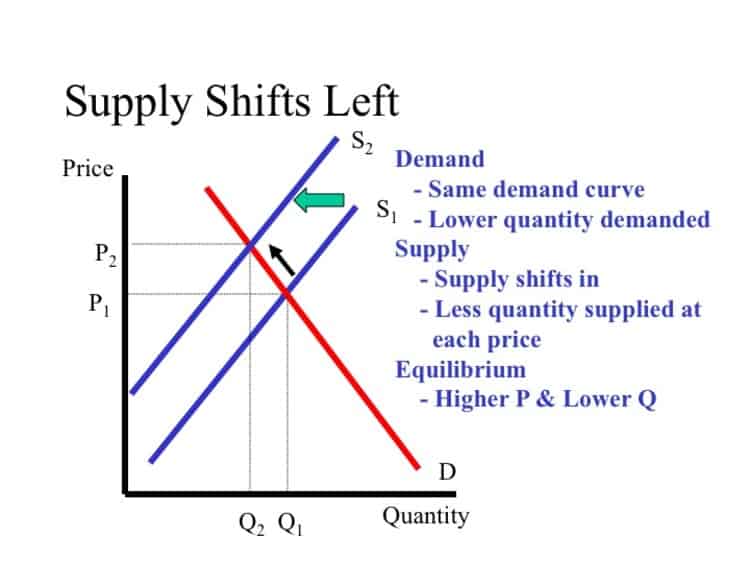
As Jonah Berger, who I quoted in the previous technique, says in his book (emphasis mine):
Scarcity and exclusivity boost word of mouth by making people feel like insiders__. If people get something not everyone else has, it makes them feel special, unique, high status. And because of that they’ll not only like a product or service more, but tell others about it. Why? Because telling others makes them look good.
If your offers are exclusive, they will be desired and valued higher. But you can’t just put an “Exclusive” sticker into your products and make them exclusive.
Exclusivity is a matter of perception. If you make your offer look exclusive, it soon will be. Take a look at how the people from Convince and Convert, a top marketing agency, position their services. They focus on differentiating from other agencies, explain their USP, and show proof of the clients with whom they work.
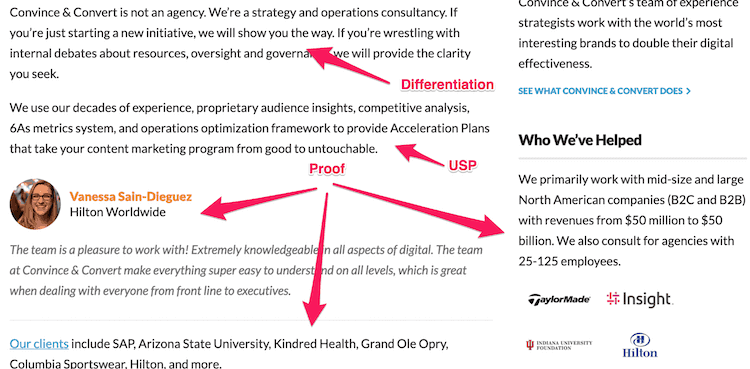
Here’s where marketers start to gain a bad rep of liars and manipulators. To some extent, it is true that marketers often like about the exclusivity of an offer. As always, this depends on the ethics of the marketer at hand. Some will be honest, some not.
What’s truly important is that you inject exclusivity into your offers.
According to Professor Berger, exclusivity has another benefit: the mere act of talking about exclusive things makes them high-authority. This status can be traded as a “social currency” (emphasis mine):
Just like the clothes we wear and the cars we drive, what we talk about influences how others see us. It’s social currency__. Knowing about cool things—like a blender that can tear through an iPhone—makes people seem sharp and in the know. So to get people talking we need to craft messages that help them achieve these desired impressions.
Social currency explains why rich people talk about yachting, golfing, and horse riding when few middle-class people wouldn’t even care to talk about those topics.
Yachts are expensive and exclusive, thus speaking about them makes you exclusive. I mean, why would I talk about yachts if I can’t use one? That’d be even worse than if I didn’t even talk about them; it’d make me look like a show-off.

You may think of arousal as a sexual concept. Rest assured, this is not the case.
Arousal is an emotional state in which you feel energized and alive. According to a paper developed by Margaret B. Bradley and Peter J. Lang, both researchers from the University of Florida, arousal forms part of a three-dimensional model called the “Valence-Arousal-Dominance” model of emotion classification.
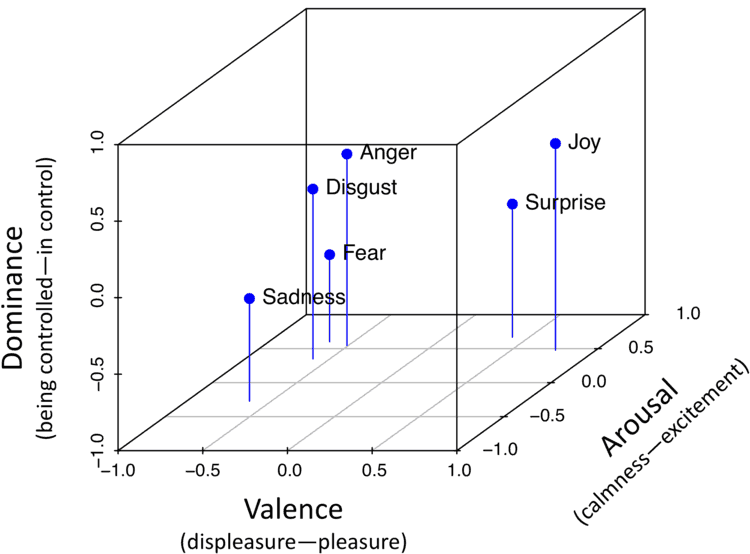
In this model, arousal represents the intensity on which you feel a given emotion: something that excites you is high-arousal; something that’s relaxing is low-arousal. Regardless of whether it’s a positive or negative emotion (the “valence” part of the model), arousal measure the level on which you feel any given emotion.
When you write copy, you want to increase your reader’s arousal as much as possible. You want your readers to react to your content with intensity. The more you arouse people, the more likely you will move them into following you. As Jonah Berger says (emphasis mine):
We need to focus on feelings__; the underlying emotions that motivate people to action.
Writers often create content with a bland intent; they don’t want to “bother” they readers, so they never make a strong opinion about something they believe in. Psychology shows that’s wrong. Your content must pike the reader’s arousal; make them happy, angry, hopeful, worried, committed, anxious, or whatever strong feeling that makes people feel something in their stomachs.
A recent study done by Jacopo Staiano of Sorbonne University and Marco Guerini of Trento Rise found that the higher the arousal—like the angrier or happier the reader became—the more likely it’d become viral.
UpWorthy, the massively popular (news?) site, often uses high-arousal elements to their viral stories. In their famous How To Make That One Thing Go Viral slide, where they explain the way they construct their viral stories, they show the following quadrant:
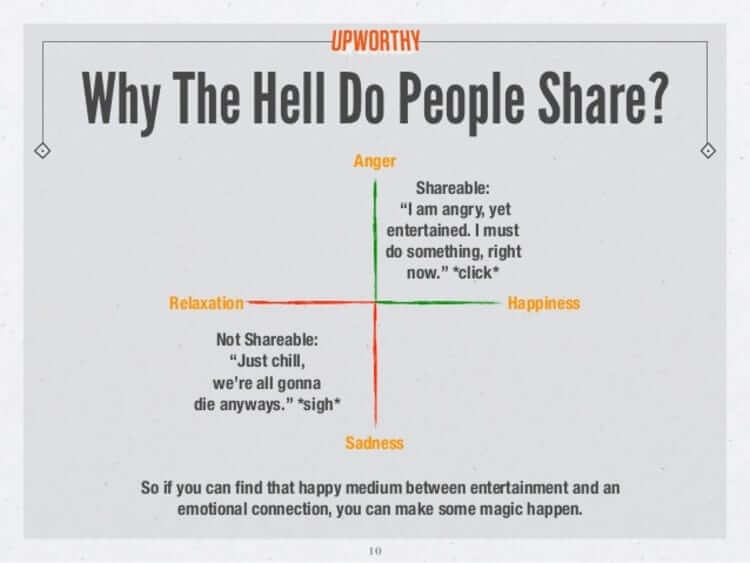
Take a look at Upworthy, and you will see they always play with your arousal:

We can say the same for most popular media sites, even in the business industry:

What makes you either angry or happy can become viral. While they focus on both negative and positive traits, their approach that lays underneath the surface is one where high-intensity emotions prevail.
This idea of high-arousal leads to action was shown to be true by yet another study done by Jonah Berger and Katherine L. Milkman, who found that positive content tends to correlate more with virality. And the former also says in his book that arousal is “one reason funny things get shared.”
The best proof of the power of arousal is the recent Nike’s Colin Kaepernick ads. People went bananas with these ads, many people going as far as burning their Nike’s shoes in reaction to these ads. Did Nike get a negative backlash in its revenues or stock price? Not at all. Actually, the ad helped Nike increase their market value by 9%.

It’s all thanks to the arousal, baby.

The movie Inception is one of the most mind-blowing movies of this decade and one of my favorites as well. If you’ve seen it, you got so hooked after the last shot, where you’re wondering what the fuck happens after the movie ends (a good example of high-arousal storytelling).

Soon after that movie came out, everyone started to refer to the idea of “Inception” to the action of putting an idea in someone’s mind without them realizing it.
Imagine if you had that power: you’d be able to persuade people without having to pull any strings or push any buttons; they would make the decision you want them to make on their own, even though you’re the one who made them make that decision in the first place.
That’d be amazing, but a bit scary, wouldn’t it?
Psychologists have discovered humans have gaps in their thought processes that make them vulnerable to such “Inception-like” influences.
It doesn’t involve hypnosis, pressure, or drugs. The name psychologists have given to the technique in which you “incept” people is priming.
Here’s how priming works:
You have an infinite amount of concepts and ideas swirling around your subconscious, the underwater sea that goes deep within your conscious mind.
Whenever you expose one of these ideas from the deep subconscious, people take that idea as more important, thus getting influenced by it.
Let’s say I wanted to sell you a Lexus IS. You like the car, but you just want a faster car, one that’s more sports-like. Any salesman, in this case, would try to convince you with facts, highlighting all the great features this car has.

But I’m no salesman; I understand psychology, and I know how to use priming to influence your brain to like this care before I even try to convince you to do so.
Before I even say anything about its features, I conspicuously say: “the Lexus IS is like the Usain Bolt of cars.”
A simple remark. Lexus and Usain Bolt have nothing to do with one another, yet somehow, deep into your brain, I get to open a little door that touches your subconscious. All of a sudden, the waters start to move. Your head starts to magically make sense of the things I told you about the car.
All of a sudden, the car seems fast. You like it a lot more. You actually want to buy it.
How did I get to do that? I didn’t push you into believing that.
What happened is that I primed you. I used a previous idea you had in your mind (Usain Bolt, the fastest man ever) and use it to transfer some of its properties into another one (the Lexus IS).
Of course, this is an oversimplification of the concept, and some will say this isn’t representative of how the process actually works. But the idea is the same:
I use certain words that trigger an idea in your mind, and then you connect those ideas with a new one, so then the former’s properties are transferred onto the latter.
Before you know it, you’ve been primed.
Robert Cialdini, the OG who wrote Influence: The Psychology of Persuasion, shares an insightful study in this video.
“One online furniture store tested images of fluffy clouds vs. cold hard cash on its home page.”
Those who saw the background depiction of clouds searched the site for more comfortable furniture. Those who went to the site that had money in the background became cost-conscious and preferred to purchase less expensive furniture.

Just by looking at clouds you become more comfort-seeking; looking at money makes you cost-saving. Isn’t that weird?

Exclusivity is a status-inducing attribute. When you make your offers exclusive, they immediately become high-status.
Close to exclusivity, another way to increase the appeal of your offers and make them look more valuable is to focus on authority.
Authority plays into an anthropological trigger in people’s minds. Whenever the chief of our tribe (i.e., the person we consider the top authority in any given social group, like your company) tells you something, you listen and obey.
Remember that humans are social creatures. We live in social structures—tribes, cultures, civilizations—with hierarchies. There are people at the top whose authority is above everyone, and there are people below it whose authority isn’t as high.
To prove this point, take what’s possibly the most fucked-up psychology study ever done: the Milgram experiment.
In this experiment, a group of regular Americans was told to administer an electric shock every time someone in another room (who was supposedly learning something) made a mistake.
The key finding of this sick study was that humans follow whatever orders they’re given by someone consider as an authority, regardless of the negative consequences of their actions. If an authority figure gives you an order, you follow it.
You. Follow. Orders.
Robert Cialdini, the Ph.D. professor author of the highly-cited book Influence: The Psychology of Persuasion, calls this the “Authority principle.”
We rarely agonize to such a degree over the pros and cons of authority’s demands. In fact, our obedience frequently takes place in a click, whirr fashion, with little or no conscious deliberation. Information from a recognized authority can provide us a valuable shortcut for deciding how to act in a situation.
We’re not stupid; we’re humans—and humans like authority. Deal with it, bro.
Authority doesn’t come just in imperative orders; if that was the case, you could easily make a sale by telling your visitors to buy your products. Instead, authority can also be shown through the use of subtle words. That is, through the use of authoritative expressions.
When I say you need to use “authoritative expressions,” I’m talking about a barely-perceivable set of words that show you know what you’re writing (or talking) about.
More often than not, writers and marketers alike use expressions like:
I get why you could use these expressions: you don’t want to look like a tool that tells people how to live their lives. Like water and oil, politeness doesn’t mix well with authority and persuasion.
Instead, you need to use expressions like:
(See what I just did there? 
The use of authoritative expressions will help you amplify your influence over them. Psychologists have called this effect the “Amplification Hypothesis.”
In the simplest terms, this means that by expressing an idea with certainty and authority, you make it easier for people to believe it and spread it to others.
If you’re a health expert, writing “You have to eat a healthy diet” instead of “You may want to eat a healthier diet” doesn’t make you a bad person; it makes you look like an expert.
(It also makes you a responsible person—one that takes care of her readers. Your readers will thank you and respect you for that.)
Persuasion renders a big part of its power from authority; using high-certainty expressions whenever you convey an idea or thought will help you leverage it for maximum effect.
Has anyone ever told you that it’s not important what you say, but how you say it?
Well, they were wrong.
What you say doesn’t matter as much as when you say it.
The reason for the way in which you structure your ideas matter much more than you’d imagine because humans aren’t that good at processing information.
Whenever someone tells us two pieces of information, we tend to put more weight on one than on the other one.
This is called the “anchoring effect,” and ever since it was discovered by Daniel Kahneman and Amos Tversky, it changed the way people—especially those at sales and marketing departments—present information.
The anchoring effect is a “cognitive bias” (or a “mental fuckup,” as I like to call it), which happens when “people consider a particular value for an unknown quantity before estimating that quantity.”
That means, when you don’t know the price of something, you’re easily influenced by the first price you’re given. Then, you carry that price throughout your purchase decision—which works like an anchor—regardless of whether that anchored price is realistic or useful.
Alternatively, if you already have an idea of how much something costs because you already have researched or bought a similar product in the past, that can also work as an anchor.
Since people are biased to accept the first piece of information they see as the basis for judging and making decisions on other information, some SaaS marketers often put the price of the most expensive plan in the leftmost of their pricing tables. By looking at the priciest plan of all, the ones they really want you to buy (the middle ones) look much better in contrast.
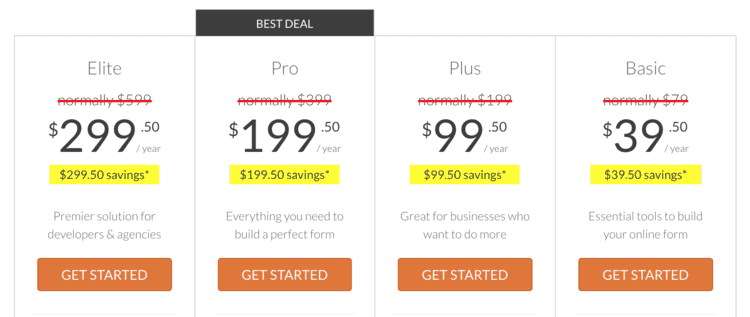
In some other cases, they highlight the main plan they want you to buy. While it doesn’t prime you in the same way as in the example from above, it does make you put all your attention into it:
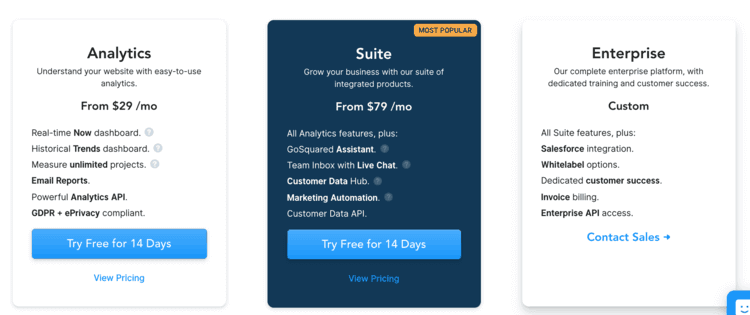
Copywriters also use the anchoring effect when they share the “real value” of all the features they give away. I once read that copywriters like to use a price that ten times the real price, so when you consider all the separate offers, they seem much cheaper than they really are.
Whatever the case, check any copywriter’s sales page, and you will see this effect in action. Russell Brunson, being an expert copywriter, uses this trick in Clickfunnels’ landing page, adding all the “paid” features that he “gives away” by a tenth of the total price you pay.

The anchoring effect shows us that we are easily influenced by uncertainty, randomness, and our own mental handicaps to value something for its true price—the price of the market.
People love movie trailers. Or sequels.
Why is it so?
Because we can’t resist what’s unfinished.
When someone gives us a hint of something, we desperately want to close that “gap.”
Psychologists, as it always happens, have a term for that: the Zeigarnik Effect.
The Zeigarnik Effect was discovered by a University of Berlin student called Bluma Zeigarnik, whose professor, Kurt Lewin, had noted the waiters in a cafe seemed to remember incomplete tabs more efficiently than those that had been paid for and were complete. Why did that happen?

Bluma Zeigarnik
Ms. Zeigarnik and her professor put the hypothesis into a test, in what would turn out to be a groundbreaking experiment for future marketers.
Ms. Zeigarnik asked 43 participants to complete a series of separate tasks, such as solving a puzzle or assembling a flat-pack box. In around half of the assignments, the experiment supervisor interrupted the participants, while in the other half, the participants completed their tasks uninterrupted.
After the experiment, Zeigarnik interviewed each participant. The results revealed that participants were able to recall details of interrupted tasks around 90% better than those that were uninterrupted.
She had confirmed that people could remember unfinished ideas very well, but not so much once they’re closed. When a task, idea, or story is unfinished, it “sticks” in your memory like glue because your brain believes it will be finished soon, and thus will be of good use.
Soon after the task is done, the idea is relieved, or the story finished, that information is no longer useful, so your brain “deletes” it.
What you need to know is that by creating curiosity gaps, you can keep the reader’s attention for much longer. Since keeping someone’s attention in the online world is so hard, you must use the Zeigarnik effect.
I love using the Zeigarnik effect whenever I start a new article, story, or section of an article (the H2 and H3 headers for the nerds out there). If you check my intros, they often start right with a punch, focusing on what you will learn from this piece.
Take a look at how I use the Zeigarnik effect in this piece on ecommerce growth hacking:
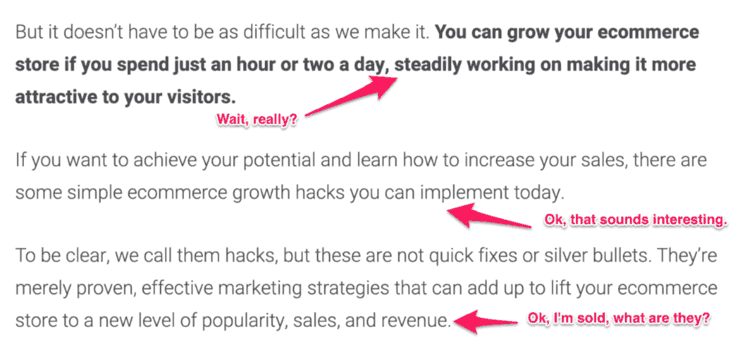
Then, I use the same effect when I explain one of these growth hacks:
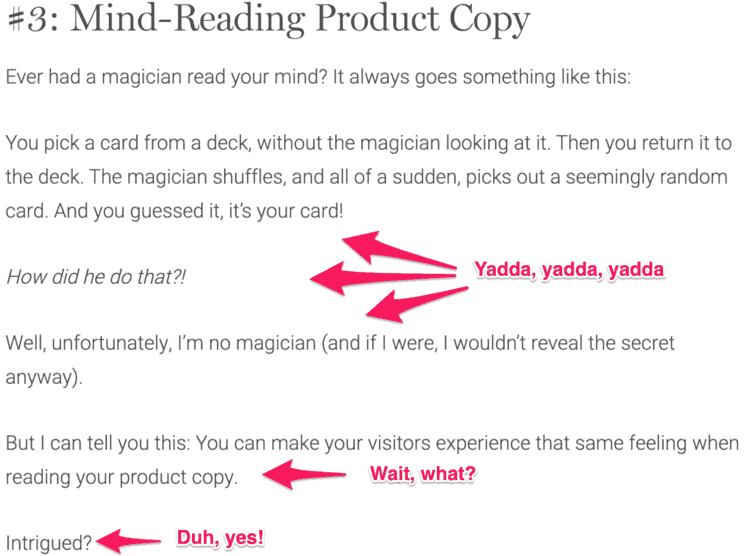
I love using this persuasive writing technique as much as possible (within the confinements of reason and honesty) because it’s a quick and easy way to make your content much more intriguing.
All top writers use this technique, like Bill Widmer does in this Sumo article:

The Zeigarnik effect isn’t a clean sheet to overextend your ideas and build too much anticipation for no reason. If you have ever seen a bad marketer at work, you know how bad it feels to see someone who’s constantly promising something that’s never delivered. It usually goes like this:
This “secret” technique the gurus don’t want you to learn will transform you into a superstar, even if you have no experience, no money, or no connections.
And they keep going on and on talking about that “secret,” until you reach the end of the page and you see that in order to discover that “secret,” you need to pay $59.99 (just for TODAY!) to see it.
The point of this persuasive technique is to avoid giving away your chips right away, and instead convey the value of your ideas before you reveal them.
There are many ways you can structure this effect within your content, but in general, they all work the same way, following a simple pain-agitation-solution framework (the P.A.S. framework I showed you in my writing techniques piece).
The pain and the agitation build the anticipation, while the solution releases the tension.

Have you ever heard that when you repeat something three times, it “sticks” more in your brain? Have you? Really, have you?
OK, with all due seriousness, if you haven’t, the “myth” states that when you repeat an idea multiple times, you remember it better.
Weird as it may seem, this effect truly exists.
Two experiments from Stefan Schulz-Hardt and colleagues demonstrated that repeating specific information during a discussion was enough to change someone’s mind.
The research team noticed that when people discuss, they tend to repeat ideas, even if they lack the substantial proof to back them up. The reason why this happens, the team thought, was due to the “mere exposure effect,” the phenomenon that explains how repeating information makes it easier for people to remember it.
On the other hand, the team thought that people do that because they use it as a social cue—an implicit way of letting you know that what they say is true.
To check their hypothesis, the researchers took 100 college students to their lab and partnered them with a trained researcher. Their job was to take two job applicants and discuss who was better qualified for the position.
At first, the participants completed a short questionnaire comparing the two job candidates. Then, each pair of students and researchers were seated together so they could discuss each applicant personally.
Throughout the discussion, the researcher either selectively repeated four pieces of information supporting the student’s choice, or four pieces of information supporting the other candidate. After they had finished their conversation, the students completed another survey asking which of the job candidates they would hire.
The research showed that nearly 70% of the students changed their initial pick if their partner repeated information supporting the other candidate. On the other hand, only 2% of the students changed their minds when their partner repeated information that supported the job applicant they favored.
That means, if the researcher supported the student’s decision, they’d keep it. If they repeated information against their decision, they’d change it.

“But wait, are you sure you want to select that candidate? Are you sure? For real?”
Talk about convictions, amirite?
What this study shows is that when you repeat a concept, you’ll increase the chances of making people understand you. It’s not that people are dumb and need to be told an idea many times until they understand it, rather it is that ideas are better understood that way.
You can repeat a single word, a phrase, a sentence, or an idea. More often than not, I like aiming for the phrase or idea, since they are catchier and seem less “heavy” for the reader.
For example, copywriter genius Joanna Wiebe shows the power of repetition in this email she sent a while back:
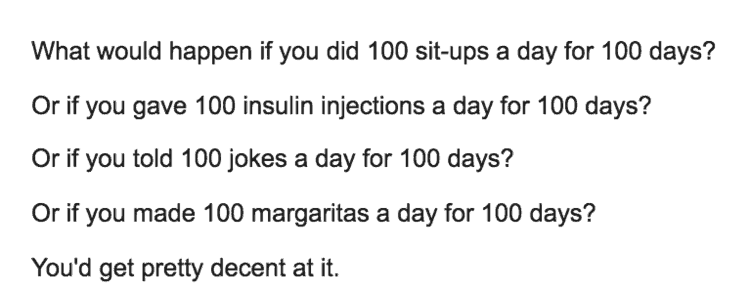
As you can see, she repeats the number “100,” but also the phrase “100 days.” Her point is to sell the idea of writing 100 headlines in 100 days. Simple and powerful.

Famous orators have used the repetition technique to make a point, build a pattern (like rappers do), and create a sense of depth to their meaning. Take a look at the closure of Martin Luther King Jr.s’ famous “I Have a Dream” speech:
So let freedom ring from the prodigious hilltops of New Hampshire. Let freedom ring from the mighty mountains of New York. Let freedom ring from the heightening Alleghenies of Pennsylvania! Let freedom ring from the snowcapped Rockies of Colorado. Let freedom ring from the curvaceous slopes of California.
But not only that. Let freedom ring from Stone Mountain of Georgia. Let freedom ring from Lookout Mountain of Tennessee. Let freedom ring from every hill and molehill of Mississippi, from every mountainside. Let freedom ring . . .
That’s the power of repetition.
You don’t need to repeat the same phrase over and over and over again, like in that sentence. Instead, aim to repeat an idea throughout your content.
So far, I’ve shared thirteen different persuasion techniques you can use to improve your marketing copy.
After reading so much, you could think that there’s a lot you’ve got to do to persuade people:
If you’re thinking about using all of these techniques right away, let me be the first one to tell you it’s not necessary to do so. Relax. Breathe.
In persuasion, simplicity matters.
Chip and Dan Heath, authors of the bestselling book Made to Stick: Why Some Ideas Survive and Others Die, explain this idea clearly:
To strip an idea down to its core, we must be masters of exclusion. We must relentlessly prioritize. Saying something short is not the mission—sound bites are not the ideal. Proverbs are the ideal. We must create ideas that are both simple and profound. The Golden Rule is the ultimate model of simplicity: a one-sentence statement so profound that an individual could spend a lifetime learning to follow it.
That means your message must be simple enough for people to understand.
When you think “Just do it,” you think of Nike, sports, and overcoming challenges. That’s a powerful message. Most importantly, its persuasive message lies in its simplicity.

Nike didn’t have to create a hundred ads explaining the technical details of their shoes, or why exercising is good for you, or how awesome it’s to train. They took a whole idea—a message—and stripped it down to its core.
Your persuasive messages must also be simple, short, and concise. That’s way harder said than done, but taking the time will pay its dividends in the future.
The Heath brothers continue explaining their message by saying:
It’s hard to make ideas stick in a noisy, unpredictable, chaotic environment. If we’re to succeed, the first step is this: Be simple. Not simple in terms of “dumbing down” or “sound bites.” You don’t have to speak in monosyllables to be simple. What we mean by “simple” is finding the core of the idea.
“Finding the core” means stripping an idea down to its most critical essence. To get to the core, we’ve got to weed out superfluous and tangential elements. But that’s the easy part. The hard part is weeding out ideas that may be really important but just aren’t the most important idea.
To this idea, Al Ries and Jack Trout, authors of Positioning: A Battle for Your Mind, agree:
The best approach to take in our overcommunicated society is the oversimplified message.
In communication, as in architecture, less is more. You have to sharpen your message to cut into the mind. You have to jettison the ambiguities, simplify the message, and then simplify it some more if you want to make a long-lasting impression.
You look for the solution to your problem not inside the product, not even inside your own mind.
You look for the solution to your problem inside the prospect’s mind.
I could go on and on explaining how to find the core by doing brainstorming, a lot of thinking, and some creative “outside-the-box” thinking. But that’d be too complicated and too rational. To honor this idea, I prefer a much simpler method, one I got from Simon Sinek.
If you’ve ever read my content, you will notice one of the books that have influenced the most to me has been Start with Why: How Great Leaders Inspire Everyone to Take Action by Simon Sinek. In this book, Sinek explains that beneath the things we do, there’s a deep “why”—a purpose—that holds the reins of your actions.
The author explains there’s a “Golden Circle,” in which at the center is our why (the reason why we do things), a how (the way we do them), and a what (the actual things we do).
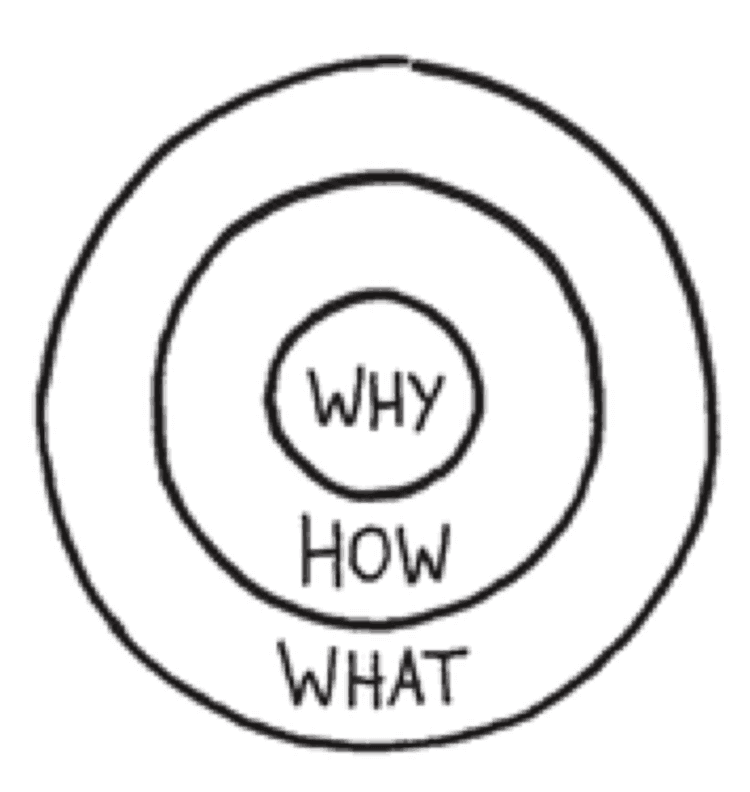
Find your why, and your actions will have a much clearer intent.
On a similar vein, if you find the “why” of your message, you will find the core message.
In the case of Nike, the main problem people face when starting a new sport is the lack of courage, energy, or experience. They could have said, “we sell sports shoes” and leave it at that, but they knew better.
No one cares about Nike’s shoes; people care about having a reason to use them.
What did Nike say? Forget the excuses, the bullshit, the lack of time, energy, or idea—just do it.
What’s the simplest way to explain your company, value proposition, and offers? That’s your core message.
If you’re still struggling, here’s a simple way you can go find your core message:
There’s no reason why your message has to be covered by a layer of copywriting techniques, explanations, and ideas. Strip it down to its core, and you will make it much more persuasive than with any other technique.
I left this technique for the end because it’s the most strange and counterintuitive of all.
Swearing is often considered as something bad and unprofessional. You risk annoying people. That’s fine for when you have a conversation, but it may not be the best tactic when you want to persuade people.

Everyone wants to be like Don Draper. But you’re no Don Draper.
Everyone wants to look professional all the time. You say the right things, and you look the part. When you want to make a sale, however, you don’t want to look like a professional sales rep who’s trying to raise your commissions, you want to help the buyer.
Swearing will break the pristine image of the salesman and will help you become more human, more real, and more honest. You’re just like the buyer, a normal person who sometimes swears.
The key to swearing, however, it’s to use it strategically.
A study done by Cory R. Scherer and Brad J. Sagarin from Northern Illinois University took 88 participants and grouped them into three sets. Each set of people saw one of three different speeches, one of which had a small swear in between. The video said:
“…lowering of tuition is not only a great idea, but damn it, also the most reasonable one for all parties involved.”
The speech only said, “damn it,” a mild swear by most people’s means, but a swear nonetheless.
In the world of online marketing, we are used to hearing a lot of fantastic, well-sounding stories of marketers who make millions with a simple “secret” that requires no experience, no money, and no pants. Marketers love to craft narratives that are too good to be true.
A few smart online marketers know this too well. Swearing is thus their magic potion that helps break through the image of the “perfect (snake oil) marketer” and build trust fast.
One of the best ones at this is one of my favorite online marketing/entrepreneurship people: Amy Hoy. She often (if not always) swears strategically in her content, making her already great pieces much more relatable.
This piece she recently published shows the story behind her “Just Fucking Ship” philosophy. Not only her story is excellent (it made me want to sign up for her email list even though I’m already a part of it 
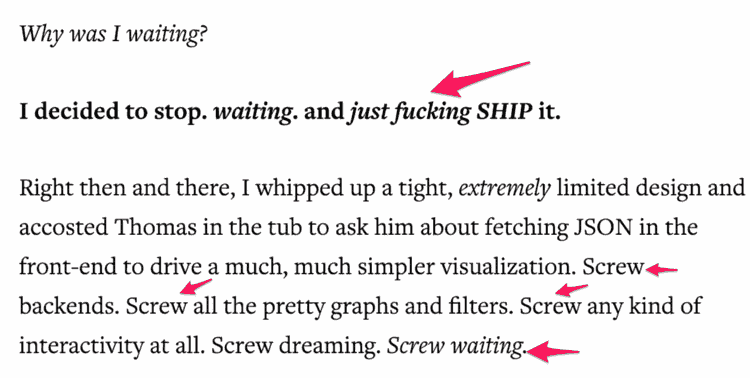
I think she only swears twice, in two separate parts, but when she does it, it’s really powerful.
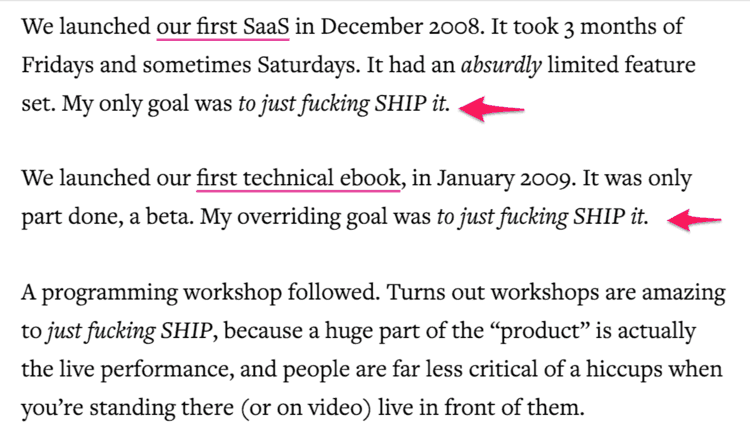
She even swears pretty heavily in her post titles, which makes them very funny and interesting to read.

Jorden Roper, from Creative Revolt, also uses strategic swearing, which probably helped her position in the creative space quickly.

She doesn’t swear all the time, mind you. In a given article, she probably swears 2-3 times, maybe up to 5, so in a 2,000-word piece, it’s not that much. But whenever she does, it makes her message much more powerful.

While some will say such use of the English language is inappropriate and disrespectful, that’s what it makes it so persuasive. People like taboos. People act naughty, even though they know they shouldn’t or that it’s wrong. So when you swear, you’re writing like you really are, like a regular human being. You don’t act like a superior man who looks down on his audience; you are one of them.
While these two examples may be a bit too extreme for some, I’d consider adding some strong swearing every so often, maybe once per article at max. In the studies mentioned above, the researchers found that the speech that influenced the participants the most was the one with the mild swear. So you may
The researchers concluded that:
Swearing at the beginning and at the end of the speech led to more positive attitudes about the topic and greater perceptions of speaker intensity. These results provide the first demonstration of the persuasive power of obscenity, and they suggest that judiciously used obscenity can increase persuasion, at least within the context of a pro-attitudinal speech.
The swearing seemed to have increased the intensity of the message.
Remember: swearing doesn’t make you a bad marketer; it makes you a more real, honest, human marketer. Just fucking swear.
One thing you can probably take from this piece is that there’s no “right” or “wrong” way to write persuasively; this depends on your audience, style, and goal.
There are some words, however, that make your readers more likely to act upon an offer, whether that’s a sale, a free gift, or email signup.
Copywriters have known this for years; they call them “power words.” We’ll call them persuasive words.
The following shortlist of words you’ll see below isn’t definitive or magic. If your writing is bad, then it won’t help much. But if you are trying to get a final push to your content, these words may persuade your audience to act.
Without further ado, here are 25 highly persuasive words you can use in your writing:
So here you have it, the ten persuasive techniques that will boost your marketing copy.
As it often happens, I originally wrote 15 persuasion writing tips, but I figured the piece was way too long for you, so I took the extra five techniques and created a separate ebook.
Click on the button below, and you’ll receive it right in your inbox.

Notifications